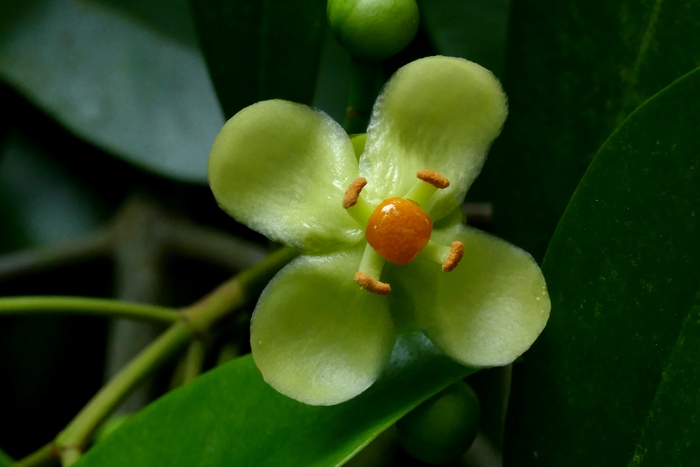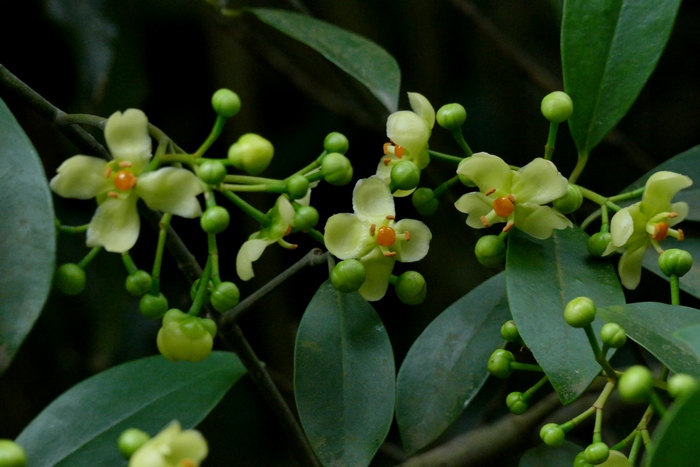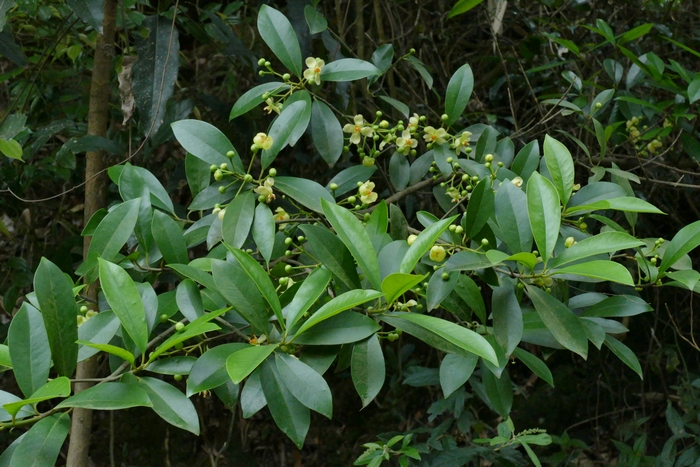木竹子 Garcinia multiflora
中文名(Chinese Name):木竹子
学名(Scientific Name):Garcinia multiflora Champ. ex Benth.
英文名(English Common Name):garcinia
别名(Chinese Common Name):多花山竹子、山竹子
异名(Synonym):Garcinia hainanensis Merr.
科属(Family & Genus):藤黄科(Guttiferae)藤黄属
形态特征(Description):乔木,稀灌木,高(3-)5-15米,胸径20-40厘米;树皮灰白色,粗糙;小枝绿色,具纵槽纹。叶片革质,卵形,长圆状卵形或长圆状倒卵形,长7-16(-20)厘米,宽3-6(-8)厘米,顶端急尖,渐尖或钝,基部楔形或宽楔形,边缘微反卷,干时背面苍绿色或褐色,中脉在上面下陷,下面隆起,侧脉纤细,10-15对,至近边缘处网结,网脉在表面不明显;叶柄长0.6-1.2厘米。花杂性,同株。雄花序成聚伞状圆锥花序式,长5-7厘米,有时单生,总梗和花梗具关节,雄花直径2-3厘米,花梗长0.8-1.5厘米;萼片2大2小,花瓣橙黄色,倒卵形,长为萼片的1.5倍,花丝合生成4束,高出于退化雌蕊,束柄长2-3毫米,每束约有花药50枚,聚合成头状,有时部分花药成分枝状,花药2室;退化雌蕊柱状,具明显的盾状柱头,4裂。雌花序有雌花1-5朵,退化雄蕊束短,束柄长约 1.5毫米,短于雌蕊;子房长圆形,上半部略宽,2室,无花柱,柱头大而厚,盾形。果卵圆形至倒卵圆形,长3-5厘米,直径2.5-3厘米,成熟时黄色,盾状柱头宿存。种子1-2,椭圆形,长2-2.5厘米。花期6-8月,果期11-12月,同时偶有花果并存。
分布(Distribution):产台湾、福建、江西、湖南、广东、海南、广西、贵州、云南等省区。本种适应性较强,生于海拔100-1900米山坡疏林或密林中。越南北部也有。
用途(Use):种子含油量51.22%,种仁含油量55.6%,可供制肥皂和机械润滑油用;树皮入药,有消炎功效,可治各种炎症;木材暗黄色,坚硬,可供舶板,家俱及工艺雕刻用材。
引自中国植物志英文版FOC Vol. 13 Page 41, 42, 43
Garcinia multiflora Champion ex Bentham, Hooker’s J. Bot. Kew Gard. Misc. 3: 310. 1851.
木竹子 mu zhu zi | Clusiaceae | Garcinia
Garcinia hainanensis Merrill.
Trees, rarely shrubs, (3-)5-15 m tall, 20-40 cm in diam. Bark gray, scabrid. Twigs gray, angled. Petiole 0.6-1.2 cm; leaf blade abaxially glaucous-green or brown when dry, ovate, oblong-ovate, or oblong-obovate, 7-16(-20) × 3-6 cm, thinly leathery, midvein raised abaxially, impressed adaxially; secondary veins 10-15 pairs, slender, joining near leaf margin; tertiary veins and veinlets inconspicuous adaxially, base cuneate or broadly cuneate, margin somewhat recurved, apex acute, acuminate, or obtuse. Plant monoecious. Male flowers sometimes solitary, sometimes in a thyrse 5-7 cm, 2-3 cm in diam.; pedicels 0.8-1.5 cm; sepals 2 large, 2 small; petals orange, obovate, 1-5 × as long as sepals; stamen fascicles stalk 2-3 mm, each fascicle with 50 anthers; anthers aggregated into a head, 2-celled, cells longitudinally dehiscent; pistillode columnar; stigma distinctly peltate, 4-lobed. Female flowers 1-5; staminode fascicles short, stalk ca. 1.5 mm, shorter than pistil; ovary oblong, wider in upper half, 2-loculed; stigma sessile, peltate, large, thick. Mature fruit yellow, ovoid to obovoid, 3-5 × 2.5-3 cm, smooth. Seeds 1 or 2, oblong, 2-2.5 cm. Fl. Jun-Aug, fr. Nov-Dec, flowers and fruit appear occasionally at same time.
Open or dense forests on mountain slopes, valley margins, secondary forests, thickets; (100-)400-1200(-1900) m. Fujian, Guangdong, Guangxi, S Guizhou, Hainan, SW Hunan, Jiangxi, Taiwan, Yunnan [N Vietnam].
This is a widely adaptable species growing in various habitats and at various elevations.
The seeds yield up to 50% oil (seed pulp up to 55% oil). The oil is used for manufacturing soap or as a lubricant for machines. The bark is used as an external medicine to reduce inflammation. The timber is hard, and is used for making furniture, boats, and woodcuts.



(责任编辑:徐晔春)
学名(Scientific Name):Garcinia multiflora Champ. ex Benth.
英文名(English Common Name):garcinia
别名(Chinese Common Name):多花山竹子、山竹子
异名(Synonym):Garcinia hainanensis Merr.
科属(Family & Genus):藤黄科(Guttiferae)藤黄属
形态特征(Description):乔木,稀灌木,高(3-)5-15米,胸径20-40厘米;树皮灰白色,粗糙;小枝绿色,具纵槽纹。叶片革质,卵形,长圆状卵形或长圆状倒卵形,长7-16(-20)厘米,宽3-6(-8)厘米,顶端急尖,渐尖或钝,基部楔形或宽楔形,边缘微反卷,干时背面苍绿色或褐色,中脉在上面下陷,下面隆起,侧脉纤细,10-15对,至近边缘处网结,网脉在表面不明显;叶柄长0.6-1.2厘米。花杂性,同株。雄花序成聚伞状圆锥花序式,长5-7厘米,有时单生,总梗和花梗具关节,雄花直径2-3厘米,花梗长0.8-1.5厘米;萼片2大2小,花瓣橙黄色,倒卵形,长为萼片的1.5倍,花丝合生成4束,高出于退化雌蕊,束柄长2-3毫米,每束约有花药50枚,聚合成头状,有时部分花药成分枝状,花药2室;退化雌蕊柱状,具明显的盾状柱头,4裂。雌花序有雌花1-5朵,退化雄蕊束短,束柄长约 1.5毫米,短于雌蕊;子房长圆形,上半部略宽,2室,无花柱,柱头大而厚,盾形。果卵圆形至倒卵圆形,长3-5厘米,直径2.5-3厘米,成熟时黄色,盾状柱头宿存。种子1-2,椭圆形,长2-2.5厘米。花期6-8月,果期11-12月,同时偶有花果并存。
分布(Distribution):产台湾、福建、江西、湖南、广东、海南、广西、贵州、云南等省区。本种适应性较强,生于海拔100-1900米山坡疏林或密林中。越南北部也有。
用途(Use):种子含油量51.22%,种仁含油量55.6%,可供制肥皂和机械润滑油用;树皮入药,有消炎功效,可治各种炎症;木材暗黄色,坚硬,可供舶板,家俱及工艺雕刻用材。
引自中国植物志英文版FOC Vol. 13 Page 41, 42, 43
Garcinia multiflora Champion ex Bentham, Hooker’s J. Bot. Kew Gard. Misc. 3: 310. 1851.
木竹子 mu zhu zi | Clusiaceae | Garcinia
Garcinia hainanensis Merrill.
Trees, rarely shrubs, (3-)5-15 m tall, 20-40 cm in diam. Bark gray, scabrid. Twigs gray, angled. Petiole 0.6-1.2 cm; leaf blade abaxially glaucous-green or brown when dry, ovate, oblong-ovate, or oblong-obovate, 7-16(-20) × 3-6 cm, thinly leathery, midvein raised abaxially, impressed adaxially; secondary veins 10-15 pairs, slender, joining near leaf margin; tertiary veins and veinlets inconspicuous adaxially, base cuneate or broadly cuneate, margin somewhat recurved, apex acute, acuminate, or obtuse. Plant monoecious. Male flowers sometimes solitary, sometimes in a thyrse 5-7 cm, 2-3 cm in diam.; pedicels 0.8-1.5 cm; sepals 2 large, 2 small; petals orange, obovate, 1-5 × as long as sepals; stamen fascicles stalk 2-3 mm, each fascicle with 50 anthers; anthers aggregated into a head, 2-celled, cells longitudinally dehiscent; pistillode columnar; stigma distinctly peltate, 4-lobed. Female flowers 1-5; staminode fascicles short, stalk ca. 1.5 mm, shorter than pistil; ovary oblong, wider in upper half, 2-loculed; stigma sessile, peltate, large, thick. Mature fruit yellow, ovoid to obovoid, 3-5 × 2.5-3 cm, smooth. Seeds 1 or 2, oblong, 2-2.5 cm. Fl. Jun-Aug, fr. Nov-Dec, flowers and fruit appear occasionally at same time.
Open or dense forests on mountain slopes, valley margins, secondary forests, thickets; (100-)400-1200(-1900) m. Fujian, Guangdong, Guangxi, S Guizhou, Hainan, SW Hunan, Jiangxi, Taiwan, Yunnan [N Vietnam].
This is a widely adaptable species growing in various habitats and at various elevations.
The seeds yield up to 50% oil (seed pulp up to 55% oil). The oil is used for manufacturing soap or as a lubricant for machines. The bark is used as an external medicine to reduce inflammation. The timber is hard, and is used for making furniture, boats, and woodcuts.



(责任编辑:徐晔春)
踩一下[0]

顶一下[2]